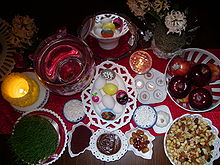Detention sin
Haft Sin ( Persian هفت سین, seven "S") are seven elements with which the Sofre (سفره"Tablecloth", also "table") of the Nouruz festival (Persian New Year), which is then Sofre-ye Haft Sin (سفرهٔ هفت سین) at the beginning of spring (around March 21) in Iran and in a large part of the Persian-speaking cultural area. The cloth is spread out on a table or on the floor and the objects are placed on it, with a mirror usually in the background, the candles next to the mirror, the book in front of the mirror. Today's customs do not all go back to Zoroastrian rites, but are partly of more recent origin and were also changed in the course of Islamization. However, the individual components of the decoration have symbolic meanings, some of which point back to ancient Iranian times. They refer to the celebrations of Farvardagān , the festival of All Souls of the Zoroastrians , when the souls of the deceased come down to celebrate with the living.
Contrary to popular belief, the number of elements whose Persian names in Iran start with the letter Sin (س, DMG S ) and are set up, the number seven, tradition also includes elements for the decoration of the Sofreh whose name does not begin with Sin. The festive table is not only decorated on Nouruz, but also on other occasions, such as weddings (haft sin-e aghd).
The interpretation of the objects is different. The Iranian scientist Nasser Engheta explains the seven compulsory components of Sofreh-e Haft Sin as follows :
- Sabze (سبزه"Green", here: "wheat", "barley" or "lentil sprouts") symbolizes liveliness ( sabz o choram "alive and well")
- Samanak / Samanou (سمنو" Malt from wheat") symbolizes benefit and blessing
- Sir (سیر "Garlic") symbolizes protection
- Sendsched (سنجد" Whitebeam ") symbolizes the seed or the germ of life
- Serkeh (سرکه" Vinegar ") symbolizes patience and happiness
- Somagh (سماق" Spice sumach ") symbolizes the taste of life
- Sib (سیب" Apple ") symbolizes beauty and health
The Haft-Sin table can also be decorated with other elements:
- Sonbol, also spoken Sombol (سنبل" Hyacinths ") symbolizes friendship
- Sekeh (سکه "Coin") symbolizes prosperity
- Ayineh (آیینه "Mirror") symbolizes purity and honesty
- Shame ' (شمع "Candle") symbolizes fire
- Tochm-e morgh-e rangi (تخم مرغ رنگی"Colored chicken eggs"). The egg symbolizes fertility. The number depends mostly on the number of family members, four people = four eggs. They are comparable to the Easter eggs .
- Mahi ghermez (ماهی قرمز"Rotfisch", goldfish ) in the water symbolizes happiness. Alternatively, narendsch ( نارنج " bitter oranges ") are placed in a bowl with clear water.
- Ketab (کتاب"Book") symbolizes wisdom; are customary The sofa of Hafez , the Shahnameh of Abul Qasem-e Ferdousi , or, depending on the denomination Avesta , the Koran , the Bible or Tora .
In addition to the Haft Sīn, there is often also a bowl with traditional desserts or classic pastries (شیرینی سنتی Schirini-ye sonnati ), another bowl filled with various nuts, pistachios and dried fruits (آجیل Ajil ), a bottle filled with rose water (گلاب Golab ), photo (s) of loved ones - mostly the deceased or children, especially if they live abroad - as well as a small national flag on the table that reminds you of your home country abroad.
Web links
- Nirupars: Noruz
- Festivals of Religions: Nowruz
gallery
Individual evidence
- ↑ a b electricpulp.com: HAFT SIN - Encyclopaedia Iranica. Retrieved March 19, 2017 (English).
- ↑ Paul Kriwaczek: In Search Of Zarathustra: The First Prophet and the Ideas that Changed the World . Orion, 2011, ISBN 978-1-78022-140-3 ( google.de [accessed March 19, 2017]).
- ↑ Some found and found, e.g. As in Afghanistan, also objects that the German- sch appropriate letter Shin (ش, DMG schin ) start using
- ↑ electricpulp.com: HAFT SIN - Encyclopaedia Iranica. Retrieved March 19, 2017 (English).
- ↑ Ketab Haftsin ("The Book of Haft Sin ", Persian)
- ↑ In other states e.g. B. Afghanistan Samanak is made from seven types of grain
- ↑ Before the Islamization of Iran, wine (Persian sharāb ) was set up as a symbol of happiness








